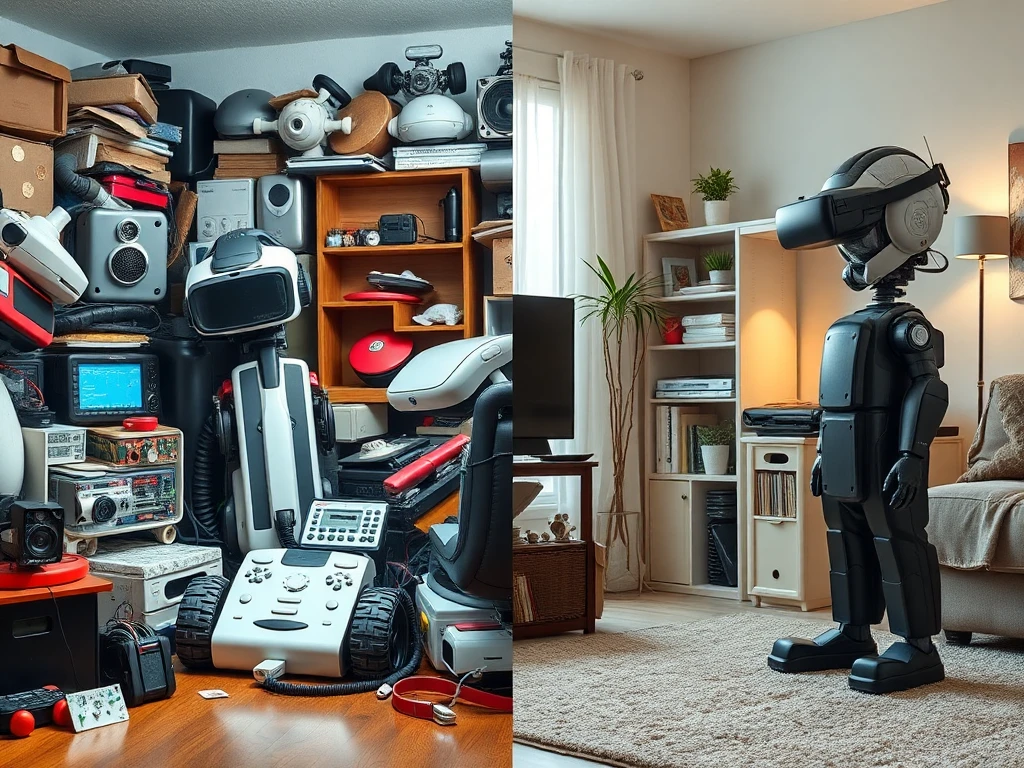Tech Evolution: Amazing Gadgets Everyone Laughed At, Now Essential

Remember when predicting the future of technology felt like pure science fiction? What if we told you some of the most ubiquitous devices in your home today were once considered laughable failures? In a world obsessed with rapid advancements, especially in areas like digital currencies and blockchain, it’s easy to forget that the path to groundbreaking Tech Evolution is often paved with awkward prototypes and missed steps.
Understanding Failed Gadgets and Why They Matter
Back in the 90s and early 2000s, inventors had bold visions, but the technology and market weren’t always ready. Many early attempts at what we now consider essential Modern Technology were too expensive, too clunky, or simply didn’t work well enough. These Failed Gadgets weren’t just commercial flops; they were crucial learning experiences. They showed what consumers didn’t want (yet) and highlighted technical hurdles that needed overcoming. Examining these early missteps provides valuable insights into the unpredictable nature of innovation and adoption.
Innovation History: Lessons From Early Tech Attempts
Let’s revisit some of these devices that went from punchlines to powerhouses. Each one represents a chapter in Innovation History, proving that sometimes, an idea is just waiting for the right moment, and the right technology, to succeed.
1. The Rocky Road of Robot Vacuums
The Electrolux Trilobite (2001) was the first consumer robot vacuum. It featured advanced tech like ultrasonic sensors but struggled with basic tasks, missing spots and getting stuck. Its high price tag (around $1,850 adjusted for today) kept it out of reach for most.
Why it stumbled:
- Poor navigation and edge cleaning.
- Frequent errors and getting stuck.
- Prohibitively expensive.
Now: Robot vacuums are affordable and smart. Models use AI, cameras, and LiDAR for efficient cleaning, object avoidance, and smart mapping, becoming common household helpers.
2. Wearable Tech’s Quirky Beginnings
Sega’s Dreamcast VMU (1998) was a memory card with a tiny screen for mini-games or stats. It was a novel idea for a second screen but had short battery life, limited function, and weak developer support.
Why it stumbled:
- Limited battery life.
- Basic functionality.
- Lack of third-party content.
Now: Smartwatches offer deep phone integration, payments, health tracking, and notifications. They are essential extensions of our mobile devices.
3. The Dream of a Home Robot Companion
Sony’s first AIBO (1999) was a robotic dog with basic interactions. At $2,500, it was a pricey novelty with repetitive behavior and no long-term support.
Why it stumbled:
- High cost, low utility.
- Shallow interaction.
- No ongoing support.
Now: Home robots have specialized. Some assist with tasks (Amazon Astro), others focus on nuanced companionship (reimagined AIBO, Loona), learning and responding more naturally.
4. VR Headsets: A Blurry Start
Nintendo’s Virtual Boy (1995) was an early attempt at 3D gaming. It caused eye strain, headaches, and discomfort due to its red-on-black display and poor ergonomics. It had a tiny game library and was quickly discontinued.
Why it stumbled:
- Physical discomfort and health issues.
- Poor graphics and user experience.
- Limited content library.
Now: Modern VR headsets feature high-resolution color displays, spatial tracking, and diverse content for gaming, work, and fitness. They deliver on the immersive vision Virtual Boy attempted.
5. The Ancestor of the Smartphone
The AT&T EO (1993) combined phone, fax, modem, and PDA functions. It weighed over two pounds, cost up to $3,000, and had poor battery life. It was a pioneer but too early and too unwieldy.
Why it stumbled:
- Too bulky and heavy for mobile use.
- High power consumption.
- Excessive price point.
Now: Smartphones integrate communication, computing, cameras, and apps into powerful, pocketable devices, making the EO seem primitive by comparison.
6. Portable Computing’s Niche Player
Sharp’s Zaurus line (like the 2005 SL-C3000) was a rare pocket-sized Linux PC. Loved by enthusiasts for its flexibility, it failed mainstream due to high price, clunky connectivity, and buggy software.
Why it stumbled:
- Appealed only to a technical niche.
- Unreliable wireless connectivity.
- Outcompeted by cheaper alternatives.
Now: The spirit lives in the Raspberry Pi ecosystem and DIY NAS setups, offering affordable, flexible computing platforms for various home projects, supported by large communities.
7. The PDA That Couldn’t Read
Apple’s Newton MessagePad (1993) pioneered handheld computing with stylus input and handwriting recognition. Its core feature failed spectacularly, misinterpreting words and becoming a source of ridicule. It was also bulky, slow, and expensive ($700).
Why it stumbled:
- Inaccurate handwriting recognition.
- Large size and high cost.
- Short battery life and limited features.
Now: Tablets like the iPad Pro offer precise stylus input, fast processors, and cloud sync. Handwriting apps make note-taking seamless on powerful, sleek devices.
8. Gaming on the Go, Evolved
The mini-games on Sega’s VMU (1999), like the Chao Pet, offered early portable interaction. They were shallow, battery-draining, and tied to the console experience.
Why it stumbled:
- Limited gameplay depth.
- Dependent on the main console.
- Poor battery life.
Now: Portable gaming devices like the Nintendo Switch and Steam Deck play full AAA games with high-quality displays and controls. Cloud gaming options further expand mobile gaming possibilities.
9. Digital Money Evolution: From Early Experiments to CBDCs
Early attempts at Digital Currencies like Finland’s Avant (1993) and David Chaum’s DigiCash (1990) offered visions of electronic value. Avant was a prepaid card, DigiCash aimed for anonymous transfers. Both failed due to low demand, poor infrastructure, and regulatory issues.
Why they stumbled:
- Lack of merchant and user adoption.
- Scalability and usability problems.
- Unsustainable business models.
Now: Central Bank Digital Currencies (CBDCs) are being explored or piloted by over 130 countries. Examples include the SandDollar (Bahamas), eNaira (Nigeria), Digital Rupee (India), and Digital Yuan (China). They are used for various transactions, marking a significant evolution in state-backed digital money, building on lessons from earlier Digital Currencies experiments.
10. The Unlikely Kitchen Staple: Air Fryer
Fred van der Weij’s mid-2000s prototype was a giant, crude device designed to make oil-free fries. It was a proof-of-concept, not a consumer product, built from basic materials and impractical for home use.
Why it stumbled:
- Massive size and impractical design.
- Built with crude, non-consumer materials.
- Never intended for mass production.
Now: Air fryers are sleek, countertop appliances using refined convection technology. They roast, bake, reheat, and dehydrate, often replacing ovens. They are one of the most popular kitchen tools globally.
Lessons from Innovation History
The journey of these ten items from derided concepts to essential tools highlights a key principle in Innovation History: failure is often a necessary step. Early Failed Gadgets provide the blueprints and lessons needed for later success. The speed at which technology evolves means that yesterday’s joke can rapidly become tomorrow’s necessity. This Tech Evolution is particularly visible in the digital space, where concepts like Digital Currencies have moved from fringe ideas to national projects.
So, the next time a new piece of Modern Technology or a novel concept emerges, like those constantly appearing in the crypto space, remember the robot vacuum, the clunky VR headset, or the failed digital currency. Today’s skepticism might just be the prelude to tomorrow’s widespread adoption.
This article does not contain investment advice or recommendations. Every investment and trading move involves risk, and readers should conduct their own research when making a decision.







